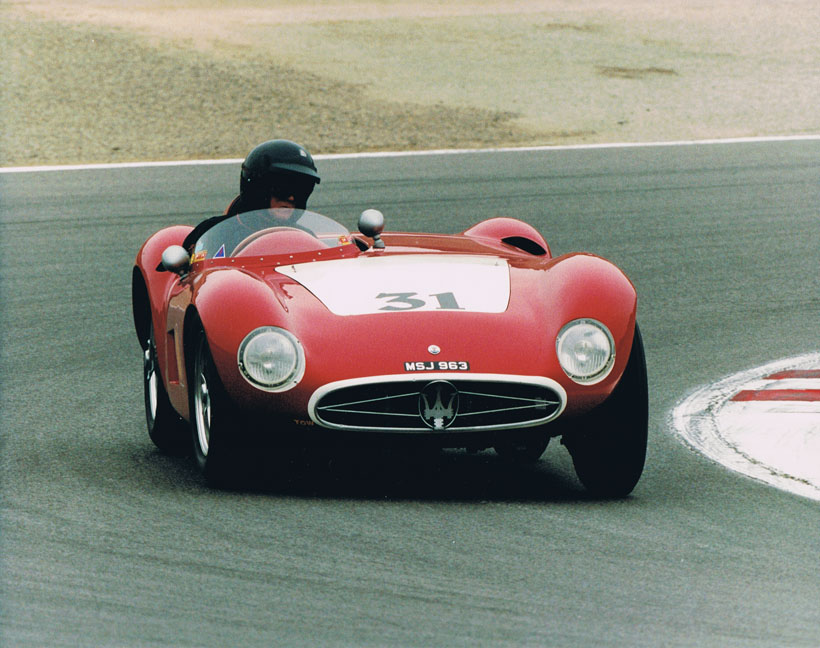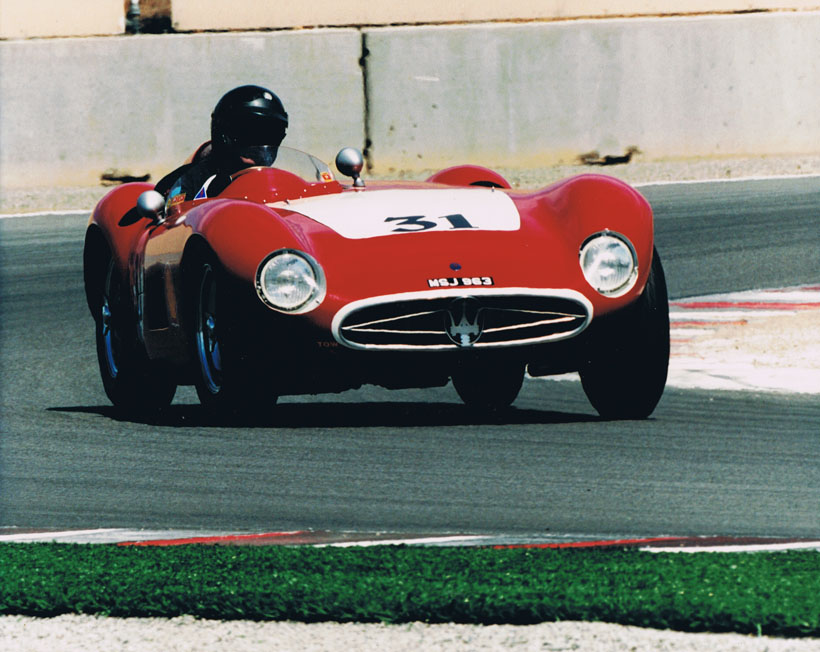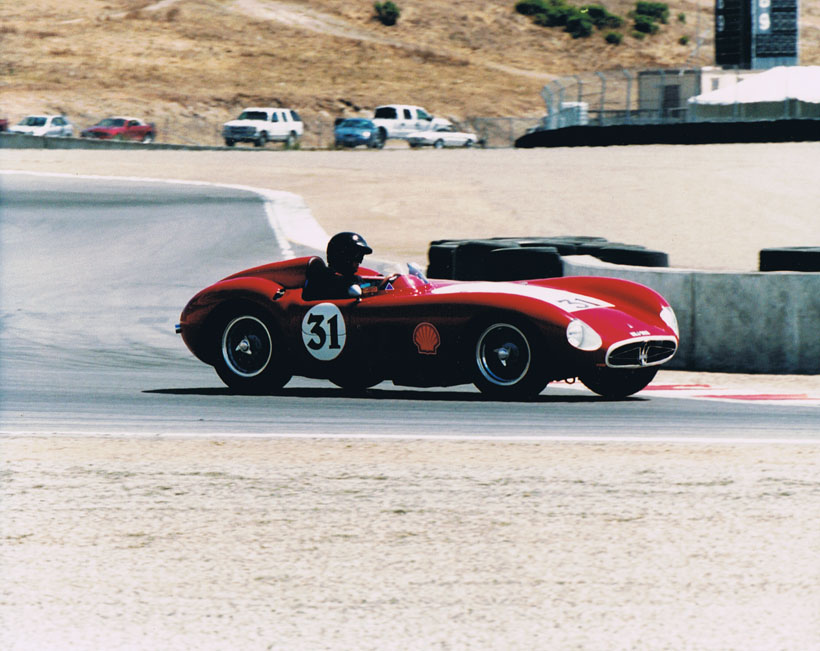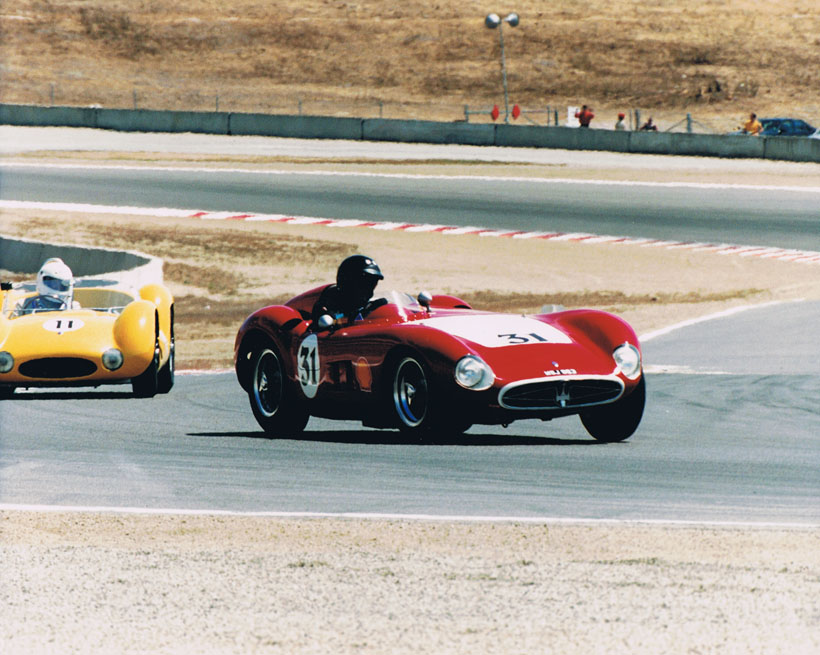Peter Giddings Racing
HISTORY OF 1955 MASERATI 300S #3057
#3057 is believed to have started life as one of two 300S prototypes. (The “Bolladi Spedizione” issued by Maserati on 23/6/1955 describes #3057 as “Dalla Casa”, meaning “prototype”). This fact, together with various chassis differences compared with later “production” 300S chassis and different rear coachwork, lighting, and number plate bracket details, supports this conviction. Nevertheless, in 1955 #3057 was sold as a new car to multiple Swiss champion Benoit Musy. #3057 was Musy’s fourth competition Maserati, his having graduated to the 300S via an A6-GCS, 150S, and 200S. Musy’s short nosed 300S (with Swiss white hood/ bonnet marking) first competed in his hands on August 7 1955 in the Swedish Grand Prix in Karlskoga (where the present owner has also raced) to a fine second place. Musy then failed to finish in the Portuguese Grand Prix of Lisbon on September 17. Musy’s 1956 season started well with a new lap record and a first in heat at the British Empire Trophy race held at Oulton Park. A week later, Ken Wharton borrowed the car, finishing a cautious sixth at Aintree. Musy took the wheel over again for the Silverstone race, finishing fifth. Three weeks later Musy stormed to a first place at the Chimay Grand Prix des Frontieres. One week later he ran at Rouen, finishing eighth. Musy next appeared in Portugal on June 7, achieving a third place. Now totally comfortable and confident in his new racer, Musy won three events in a row – the Las Sable d’Oloane Grand Prix, the Grand Prix of Bari, and the Swedish Grand Prix (this time held in Kristianstad). During Musy’s ownership, #3057 was regularly serviced/ updated by the Maserati factory. After such a stunning #3057 debut, it is no wonder that prior to the October Coupe de Paris, Monthlery Benoit Musy was approached by Omer Orsi (president/ owner of Maserati) offering a factory sponsored contract drive in both formula one (250F) and sports racing (250S/ 300S/ 450S). Sadly, Benoit Musy was killed at the succeeding Monthlery race when the steering failed on his borrowed Maserati 200S. After Musy’s sad demise, #3057 returned to the factory for overhaul/ updating, after which it was put up for sale on behalf of Musy’s surviving family. On June 18 1958 the car was sold to the Automovel E Touring Clube de Angolo, where it was actively and successfully campaigned throughout Angola and South Africa (actual results still being researched). The Automovel E Touring Clube de Angola regularly returned #3057 to the Maserati factory for overhaul and updating. Such was the success and reliability of #3057, that the Clube purchased a second 300S (#3082). Thus they now owned one of the first prototype 300Ss, together with the last but one ever built! By the 70s, following the Communist revolution, most of the Portuguese residents left Angola and sadly abandoned a number of race cars including #3057. Several of these competition cars were turned into streetable sports cars, this being the fate of #3057 which ended up with an American V8 engine and gear box. Discovered and purchased by Swedish engineer Stein Johnsen in November 1989, Johnsen was forced to hide his Angola discovery in a container, the doors of which he welded up, then covering everything with earth. What Johnsen went through to spirit #3057 out of Angola is a story in itself, but by March 1991 #3057 arrived in Oslo! Purchased in February 1992 by Englishman Peter Scott and after Maserati historian, Richard Cump had pronounced #3057 as genuine, it was moved to Paul Weldon’s Church Green shop for a total ground up restoration. In conjunction with Ermano Cozza (head of Maserati Historical Research, Maserati SpA, Modena), Paul Weldon, then meticulously and authentically rebuilt #3057, utilizing most of the original coachwork, etc., all of the chassis, suspension, brakes, steering mechanism, steering wheel, gear change mechanism, tanks, instruments, seats, interior panels, etc. This painstaking project was completed by the end of 1994 and track tested by Tony Dron in Thoroughbred & Classic Cars magazine “Driving Musy’s Maserati”. In 1996 #3057 received its FIA Historic Vehicle Identity form, at which time Cozza also issued an authenticity statement on behalf of Maserati SpA, Modena.. Since 1996, #3057 has been actively campaigned, including three Coys Silverstones, Grand Prix de Monaco (Martin Stretton third place), Oldtimer Grand Prix Nurburgring (twice), Ferrari Maserati Challenge Le Mans (Michael Hinderer), Goodwood (Stretton fourth place), Ferrari Maserati Challenge Spa (Hinderer), Ferrari Maserati Challenge Brands Hatch (Hinderer), etc. #3057 then began a new competition adventure in the hands of Peter Giddings. #3057 is now being campaigned by Peter’s friend, Peter LeSaffre.
Maserati 300S at Laguna Seca: photo by Bob Dunsmore
Maserati 300S at Laguna Seca: photo by Bob Dunsmore
Maserati 300S at Laguna Seca: photo by Bob Dunsmore
Maserati 300S at Laguna Seca: photo by Bob Dunsmore |



